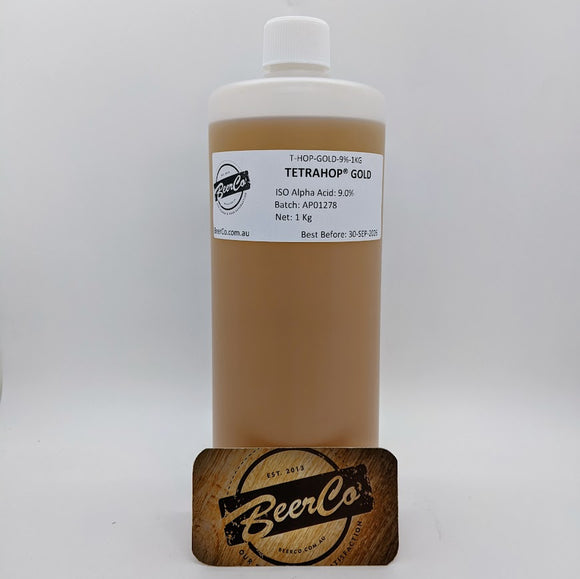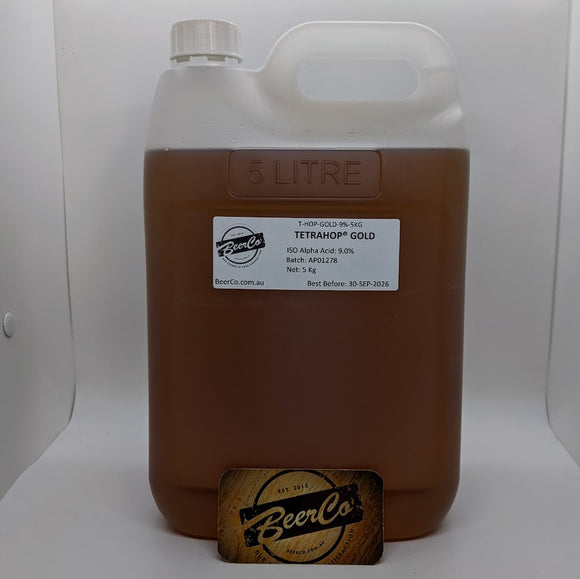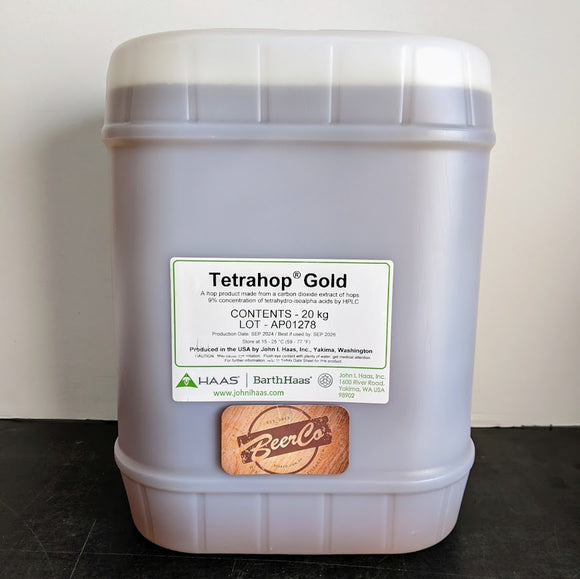Tetrahop® Gold is an aqueous alkaline solution of the potassium salts of tetrahydro-iso-alpha-acids. It is produced from CO2 hops extract using a patented all aqueous process. Tetrahop® Gold enhances beer foam when used as a postfermentation replacement for a part of the normal bittering. In the absence of normal alpha-acids and iso-alpha-acids,
Tetrahop® Gold will give complete protection from the formation of light-struck flavour. Furthermore, it will act as an antimicrobial agent when added to beer. Tetrahop® Gold is classified as a modified hop extract that may be safely used in beer in accordance with the US FDA regulation 21 CFR 172.560 (b) (6).
Pack Sizes:
- 1 Kg
- 5 Kg (SAVE 16% OFF 1 Kg Price)
- 20 Kg (SAVE 28% OFF 1 Kg Price)
Product Specifications
- Description: A yellow to amber colored, aqueous solution of the potassium salts of tetra-hydro-isoalpha- acids
- Concentration: Standard concentration is 9.0% ± 0.5 of tetrahydro-iso-alpha-acids by HPLC
- pH: 8.5 – 11.0
- Density: 1.017 g/mL (approximately) at 20 °C (68 °F)
- Viscosity: 2 - 10 mPas at 20°
- Solubility: Soluble in pH-adjusted de-mineralized water, and in alcohol
- Iso-alpha-acids: < 0.1 %
Product Use
Tetrahop Gold is normally used after fermentation and before final filtration. Utilisation of Tetrahop Gold in final beer can be expected between 55 - 80% depending on the time and efficiency of dosing (kettle dosing is not advisable). The point of addition should be close to a region of turbulent flow, e.g. on the suction side of a centrifugal pump. The dosing pump should be adjusted to deliver Tetrahop Gold over approximately 70% of the
total transfer time. It is advisable to make the addition prior to the final filtration step. Local high concentrations of tetrahydro-iso-alpha-acids should be avoided and the addition point should be well separated from that of any other additives. Tetrahop Gold may be added at ambient temperature without prior dilution directly to beer. If dilution is
necessary, the use of demineralised water and a pH adjustment to 10 – 11 with KOH is necessary. Do not use sodium bases to adjust the pH of the dilution water – caustic soda or sodium hydroxide form poorly soluble salts with most hop acids.
The amount of Tetrahop Gold is calculated based on the product concentration and the assumed utilisation. Conducting trials at the brewery will determine the correct dosage of Tetrahop Gold with regard to sensory bitterness and foam enhancement. Depending on the type of beer, Tetrahop Gold may give 1.0-1.7 times the perceived bitterness of normal iso-alpha-acids. Tetrahop Gold should not be left in dosing lines at low temperatures.
We recommend cleaning lines and dosing pumps with warm slightly alkaline demineralised.
Usage Calculations:
The following calculations are based on the assumption of tetrahydro-iso-alpha-acids (THIAA) being 1.7 times as bitter as iso-alpha-acids (IAA). Utilisation of THIAA is expected to be up to 70 - 75% when Tetrahop Gold is used as recommended.

Typical Beer Styles
- Cervezas
- Light Lagers
- Draught
- Clear and Green Bottle Beers
Foam Enhancement:
Calculate required Tetrahop Gold as shown above (for foam and cling enhancement we generally recommend Tetrahop Gold not be added to the final beer at a concentration greater than 5 ppm THIAA). Reduce kettle bittering by an equivalent BU to compensate for the bitterness contribution of Tetrahop Gold.
Light Stability:
Tetrahop Gold will only provide protection from light-struck flavour if a complete absence of normal iso-alpha-acids is achieved, therefore no other sources of non-reduced iso-alpha-acids should exist in the wort or beer streams. Thus for light-stable beers packaged in clear or green glass bottles, all the hop bitterness must be derived from reduced hop
acids such as Tetrahop Gold, Redihop or Hexahop products. Iso-alpha-acids (from equipment or yeast) must not be present in the beer. If beta extracts are used as kettle additives, ensure that the concentration of alpha-acids and iso-alpha-acids are below 0.2%
Storage and Best By Recommendation:
Store Tetrahop Gold in full, closed containers at 15 – 25 °C (59 – 77 °F). Prolonged storage at high temperatures may cause deterioration. Exposure to temperatures below 15 °C (59 °F) during storage or shipping may cause buildup of resinous precipitation. Tetrahop Gold performs best if used within 24 months from the time of production if stored as recommended. Opened containers should be used within a few days.
Analytical Methods:
The concentration of tetrahydro-iso-alpha-acids is measured by UV Spectrophotometry (with modified factors) or by the EBC Method 7.9 (HPLC).



